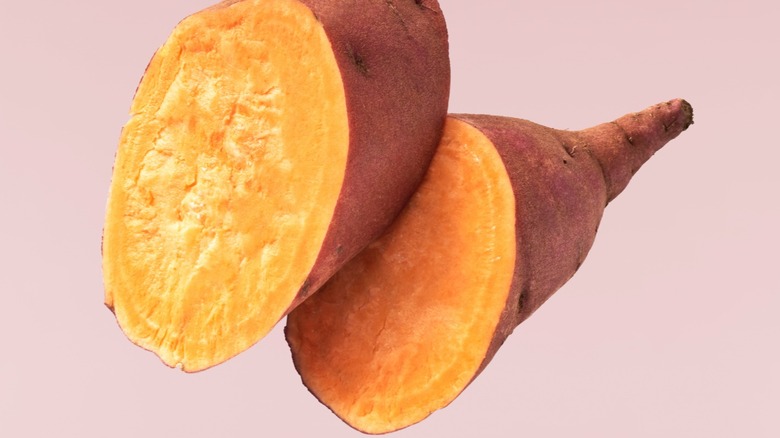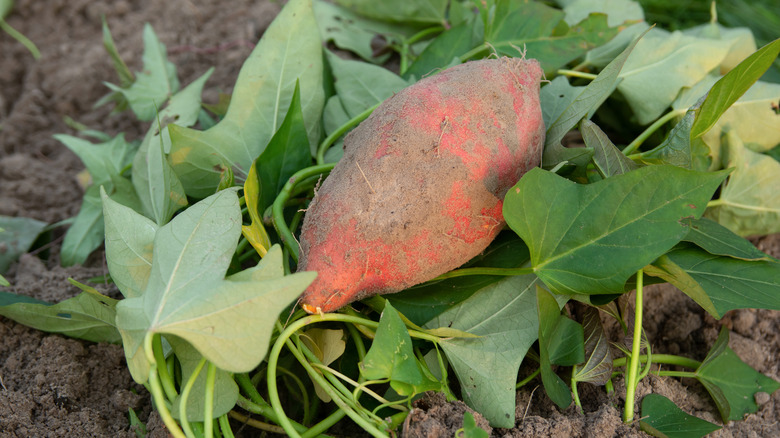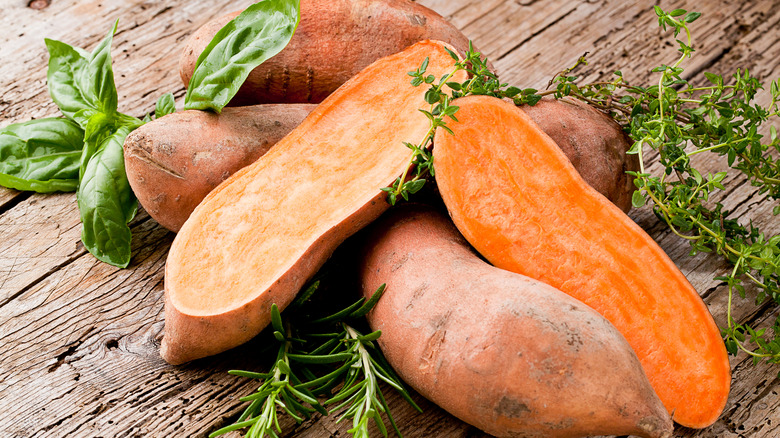What Is That White Ooze On Sweet Potatoes, And Why Is It So Important?
It's hard to turn down any colorful vegetable, let alone choices with something sweet in their very name — see sugar snap peas, sweet corn, sweet peas, and of course, sweet potatoes. Even kids love this friendly plant food that's delicious baked, fried, mashed, or roasted; plus they come in orange, purple, yellow, and white! Despite the similar ways they appear and can be enjoyed, sweet potatoes aren't actually potatoes — or even yams. According to Healthline, they belong to the morning glory family (you'll know when you see their blossoms!) and are considered a root, while potatoes are tubers in the nightshade family.
While it's an American Thanksgiving "tradition" to pile them with marshmallows, you don't need to do much to sweet potatoes to make them delicious and nothing at all to make them healthy. Healthline reports that sweet potatoes are much richer in vitamin A than white potatoes, with a little more B6, C, and calcium — plus antioxidant beta carotene, and a better glycemic index. But sweet potatoes do require some work, and when you're preparing them, you might notice beads of an unappealing white liquid. Here's what it is and what you can do about it.
It's sap, and it signifies sweetness
As explained by Southern Living, the white stuff that oozes from cut sweet potatoes is actually known as "sap." It's just starch and sugar mingling with the water in the root, and cutting it releases it from its tuberous confines. Southern Living adds that the more sap you see, the sweeter your sweet potato will be. The sap does not mean that the sweet potato is going bad; in fact, fresher sweet potatoes may be sappier. With spoilage, you'll notice an off smell, squishy feel, shriveling skin, dark spots, strange surface bumps, mold, or rot, per Lacademie — though a little sprouting is ok.
To keep your sweet potatoes as long as possible, Lacademie says you should avoid washing them until just before cooking to avoid inviting microbial growth and keep them in a dry place that's not too cold and away from the light, like your pantry — colder temperatures can damage their texture and flavor, while warmth makes them shrivel or sprout (per FoodPrint). There, they may keep for up to two months. There's also the option of blanching and freezing them. Their peels are totally edible, too, and very nutritious.
Sweet potato recipes to make at home
Now that you know the white ooze in your sweet potatoes indicates greatness, here are some unique ways to cook with them that are both healthy and heavenly. Dorothy Dalquist's sweet potato bourbon bundt cake (via Martha Stewart) is a refreshing departure from the popular pie. Cookie and Kate's sweet potato & black bean tacos are hearty enough to win over any meat eater, and roasted sweet potato salad is unexpectedly complemented with rich, tangy blue cheese. If you can find sweet potato greens, try them raw or sauteed like spinach (per Specialty Produce) and serve them with the root.
You'll definitely turn heads with Ree Drummond's purple sweet potato soup. Food Network suggests adding in ingredients like orange essence, chipotle peppers, horseradish, and curry spices. They also offer up an array of creative dishes including stuffed sweet potato skins, Insta-worthy sweet potato mushroom lasagna, and a sweet potato spin on classic summery potato salad. We have Chef Jeff Mauro to thank for these (and many more) delicious recipes featuring this versatile vegetable that's so good to us. It's time to look beyond the holiday season and eat sweet potatoes all the time.


